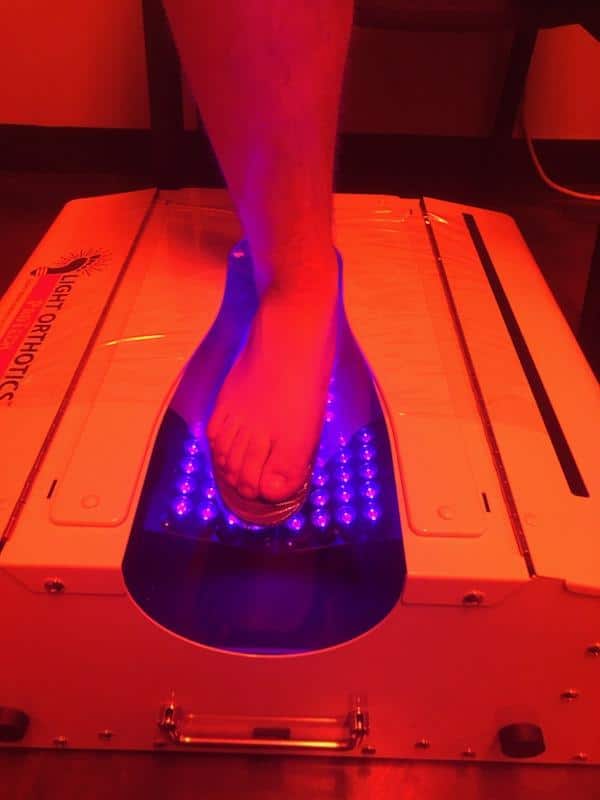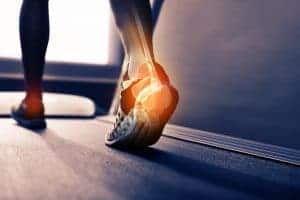
Plantar Fasciitis Treatment 101
Plantar fasciitis (pronounced PLAN-tur fas-e-I-tis) is caused by an inflammation in the heel of the foot. It is one of the most commonly diagnosed causes of heel pain in active men and women between the ages of 40 and 70. It’s primary cause is the inflammation of the thick, weblike ligament connecting your toes to your heel bone called the plantar fascia.
The pain brought on by plantar fasciitis can be debilitating. Luckily there are several in-home remedies that may be able to relieve the pain in your heel. While there have not been many medical studies into their efficacy, these methods have been used by million suffering from plantar fasciitis. You may find that they work better alone or in combination with one another.
- Get off your feet. Let your feet rest by limiting or, if at all possible, eliminate those daily activities which exacerbate your heel pain. When possible, refrain from walking or running on concrete and other hard surfaces.
- Exercising flexibility
Plantar fasciitis can be relieved and even prevented with the use of gentle stretches. Stretching your plantar fascia and calves can allow your muscles to relax and lessen heel pain.
Running is one exercise that should be avoided for a while to allow the plantar fascia to heal. You can exercise without making your heel discomfort worse by swimming and engaging in other low-impact sports. Restarting your running should be done gradually.
While exercising, take a break and stretch to prevent the pain from coming back. Stretching should also be done before working out.
- Wear proper footwear. The right arch support and good shock absorption are essential characteristics of appropriate footwear. Select an athletic shoe or a shoe with a lot of cushion in the sole.
- Always wear your shoes. Put them on as soon as you get up. Not wearing shoes or going barefoot can make the pain worse. Avoid slippers as they don’t have the support that is needed.
- Use shoe inserts. Many retailers carry shoe inserts (over-the-counter orthotics) and heel cups designed to help cushion the heel. Even if you only have pain in one foot, you should always use them in both shoes or you run the risk of developing other conditions.
- Ice your heel. Icing the affected heel will relieve the pain by reducing inflammation.
- Take a nonsteroidal anti-inflammatory drug (NSAID). Ibuprofen (such as Motrin or Advil), naproxen (for example Aleve) and other over-the-counter nonsteroidal anti-inflammatory drugs will alleviate the pain. NSAIDs are most commonly taken orally via pills but many also have a cream that can be rubbed over the sore area.
- Rest
Rest is recognized as the best treatment for plantar fasciitis by about 25% of patients. Avoiding weight-bearing activities and applying pressure to the foot reduces pain as the body heals. Even so, resting might be particularly challenging for athletes and those whose occupations include a lot of standing and walking.
Active people can attain “relative rest” by selecting activities like swimming and using upper body weight machines that have little impact and pressure on the plantar fascia.
- Shockwave Treatment
Delivering low- or high-energy shock waves to a particular location is the foundation of this therapy. The body responds to the microscopic trauma caused by the shock waves by producing a healing response. It is believed that this procedure aids in the plantar fascia’s healing process.
- Medications and Icing
Several times a day, apply ice to the sore area on your sole to reduce pain and swelling. Additionally, nonsteroidal anti-inflammatory drugs might be suggested by your doctor.
- Stretch you feet and legs. Doing simple exercises like, calf stretches, towel stretches and toe stretches can make your ligament more flexible. It will also build strength in the muscles that support your foot arch. Do them several times a day, most importantly first thing in the morning.
What is the duration of plantar fasciitis?
As soon as you begin treating your plantar fasciitis, you should notice an improvement in your symptoms. However, the time it takes for your plantar fascia to heal might range from a few weeks to a few months. Try the same at-home remedies you previously employed if you start to feel better but then your symptoms come back. If your symptoms seem different or worse than before, consult your doctor.
Can plantar fasciitis recur even after successful treatment?
Yes, plantar fasciitis can recur even after successful treatment. Recurrence is possible due to various factors, and while treatment might alleviate symptoms, the underlying causes might still be present. Some reasons for recurrence include:
- Inadequate Healing Time: Rushing back to regular activities before the plantar fascia has fully healed can increase the risk of recurrence.
- Incorrect Footwear: Wearing unsupportive shoes or shoes that lack proper arch support can contribute to recurrence.
- Overexertion or Overuse: Engaging in high-impact activities or overusing the feet without proper warm-up, stretching, and moderation can lead to a relapse.
- Improper Foot Mechanics: Issues with foot mechanics, such as overpronation, might not be fully addressed, leading to recurrence.
- Weight Gain: Gaining weight can put additional stress on the plantar fascia and contribute to its inflammation.
When might shockwave therapy be recommended as a treatment for plantar fasciitis?
Shockwave therapy, also known as extracorporeal shock wave therapy (ESWT), might be recommended as a treatment for plantar fasciitis in cases where more conservative treatments have not provided sufficient relief. This non-invasive procedure uses high-energy sound waves to stimulate healing and reduce pain. Shockwave therapy might be considered when:
- Conservative Treatments Have Failed:
If methods like rest, stretching, orthotics, physical therapy, and anti-inflammatory medications have not effectively alleviated symptoms, shockwave therapy might be explored.
- Chronic Pain:
Individuals experiencing chronic plantar fasciitis pain that has persisted for several months despite treatment might benefit from shockwave therapy.
- Avoiding Surgery:
Shockwave therapy is sometimes considered as an alternative to surgical intervention for individuals who want to explore non-surgical options.
- Limited Mobility:
If the pain and inflammation from plantar fasciitis are limiting mobility and affecting daily activities, shockwave therapy might be considered to improve function.
- Preference for Non-Invasive Treatment:
People who prefer non-invasive procedures over surgery might find shockwave therapy appealing.
When I get plantar fasciitis, will I have to leave work or school?
If an activity you engage in frequently triggered the plantar fasciitis, you might need to take a few days off of work or school while you recuperate. Inform your healthcare physician about your regular activities, especially if your job requires you to stand all day.
For at least a week, you should refrain from participating in sports and other activities that impose strain on your feet. Before starting up your vigorous exercise routine again, consult your doctor.

